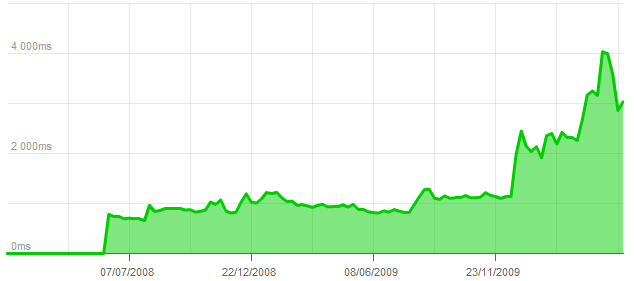I’m just settling in at the office having spent the weekend at WordCamp UK 2010 which was staged in Manchester and is a community event for WordPress users and developers. I gave two presentations, one about WordPress in Big Media, and another about WordPress in the Enterprise. These followed on from presentations given at last year’s WordCamp.
The Craic

I’m going to say now that one of the key elements of a good conference or unconference is the socialising – this is where you meet people, bond with them over beers/food/dancing and form alliances that in the future could prove to be very powerful. You certainly get to make friends and feel like you’re a part of an actual community, and this happens in a way that you’ll never be able to reproduce with online technology. As a consequence it’s no surprise that the awesome Thinking Digital conference has been nicknamed Drinking Digital by some wags.
As ever,Tony Scott excelled himself by getting us access to the famous Factory Manchester (FAC251) which also happens to be across the road from a magnificently geeky pub that sells good beers, has various classic 8 bit and 16 bit computers adorning the walls, and classic arcade games on free play. Awesome.
The Presentations
There was a typically varied range of presentations running across three rooms, along with other folk busy coding up for the WordHack (the fruits of their labours are online). One particular stream that particularly caught my attention was that of a sequence of involvement from John Adams of the Department for International Development. He ran a free-form discussion group on testing strategies which was followed by an interesting talk on PHP unit-testing Nikolay Bachiyski of GlotPress fame. This session showed up some of the lack of structure in general testing of WordPress core code, plugins and themes. Although the approaches used were probably fine for a publishing platform, they would struggle to gain ISO approval. In other words, you wouldn’t want to fly on a WordPress powered plane!
Other presentations that I particularly enjoyed were Michael Kimb Jones’s WOW plugins, and Toni Sant’s very underattended Sunday morning slot where he discused the way WP has helped with a range of Maltese websites.
The Controversy
What’s a WordCamp without at least a little controversy? However, for the attendees of this one, this was a biggie… Jane Wells is Automattic’s Master of Suggestion (seriously, that company has some weird job titles) and she made a suggestion that we shouldn’t have a WordCamp UK, but instead locally organised WordCamps for cities.
There’s a number of issues I have with this:
- Everyone in the UK knows that quite quickly WordCamp London would be the big one with all the attention in both media and attendance. It would quickly dominate – in large helped by the enormous population density of the capital. A WordCamp UK in London would be fine and popular (also considerably more expensive) but that’s all that’s needed.
- Many British cities have intense rivalries whilst we all still stand together as a nation – there are folk in Glasgow who would never attend a WordCamp Edinburgh, but would definitely be more interested in a WordCamp Scotland. End result? Cities would have small attendances by and large, and our impressive capacity for indifference for minor events would mean that they’d end up as little more than tiny, cliquey gatherings. Anyone who’s tried to run GeekUps will understand this problem.
- A lot of work, energy and our own money has been spent on building up WordCamp UK. Is Jane seriously suggesting we should dump that?
- What is Jane’s authority on this? She’s simply an Automattic employee. We chose WordCamp UK and its structure – it’s ours. If someone else wants to run a WordCamp UK in the country they’re perfectly entitled and there’s no real reason why we couldn’t have three or four running each year – that would be a huge success. A highly capitalistic organisation that is just one of thousands of contributors to the project and which plays no part in actually running most WordCamps shouldn’t get so involved.
- The UK is also very small – 90% of the population can reach all past WordCamp UKs in less than 3hrs – there is no real problem about accessibility.
- None of the UK’s key WordPress community members want to give up WordCamp UK.
- Jane admitted only six or seven people had complained to her about the situation, two of which turned out to be in Ireland – which except for a small part isn’t in the UK at all. She couldn’t confirm whether they were Northern Irish or not, which was actually something of a poor mistake to make in front of 150 or so Brits.
- Us Brits are a pretty apathetic bunch at the best of times – actually running a WordCamp in each major city would be surprisingly unlikely to happen – there were only two bids submitted for this year’s event – one in Portsmouth and one in Manchester.
- The whole point of the *camp suffix is that it’s all free and easy with no big organisations sticking their oar in. They are inconsistent and joyful. They’re fun. Automattic should keep out.
- The WordCamp name is not trademarked, and we’ve been using it in the UK for some time now. It’s ours!
Of course, there are two sides to each argument. Here’s some reasons and benefits to splitting up WordCamps in the UK:
- If somebody wished to run a WordCamp for their city they may feel that the UK badge is dominating and there’d be little interest as a consequence if it was called WordCamp Bristol, or WordCamp Salford.
- A national event called something like WordConf could happen.
- Erm…
Thing is – we can’t necessarily win this battle here in Britain. We don’t control the WordCamp.org website – Matt Mullenweg does (he has the domain registration in his name) so if we fight to keep calling it WordCamp UK there’ll be no ongoing support for the event from Matt and his team if they wish to stop the use of the UK moniker.
Which would mean standing up to them. Do we want to? Are we prepared for a fight on this? What do the likes of Mike Little (co-founder of the WordPress project) and Peter Westwood (a UK based core developer) feel about this?
Interestingly we were told the same thing applies to the likes of WordCamp Ireland which will now face this problem – but I wonder if Matt understands Ireland particularly well (we know Jane doesn’t) and that in that country the dominant WordCamp would quickly become an expensive Dublin event. You may get one doing well in Cork, but Kilkenny, with a population of just 22,000 and which staged this year’s event, probably wouldn’t be able to sustain an annual WordCamp.
So, Jane has to really allow each country to understand its own social constructs and history and let their own communities choose how they do things. One or two may complain, but it’s not possible to please everyone.
And we showed off too…
My company Interconnect IT have released, through our Spectacu.la brand, the following plugins which you may find useful:
I couldn’t help using the Discussion plugin to run some live discussion sessions.
And The Thanks
I can’t say thank you enough to the people who make WordCamp UK a success for no personal reward. Tony Scott leads it up, with Mike Little, Nick Garner, Chi-chi Ekweozor, Simon Dickson and many many more working hard behind the scenes. Also to Nikolay to letting me play with the fastest 85mm lens I ever saw! Thank you, you’re wonderful people.








